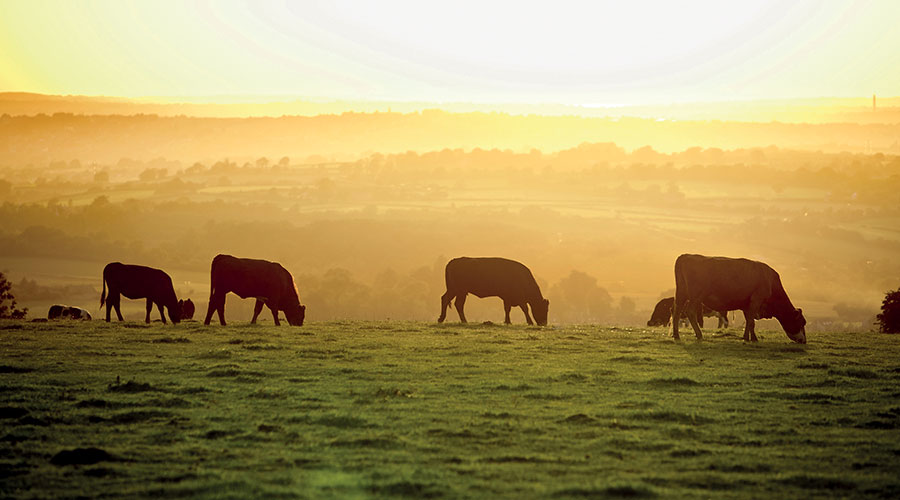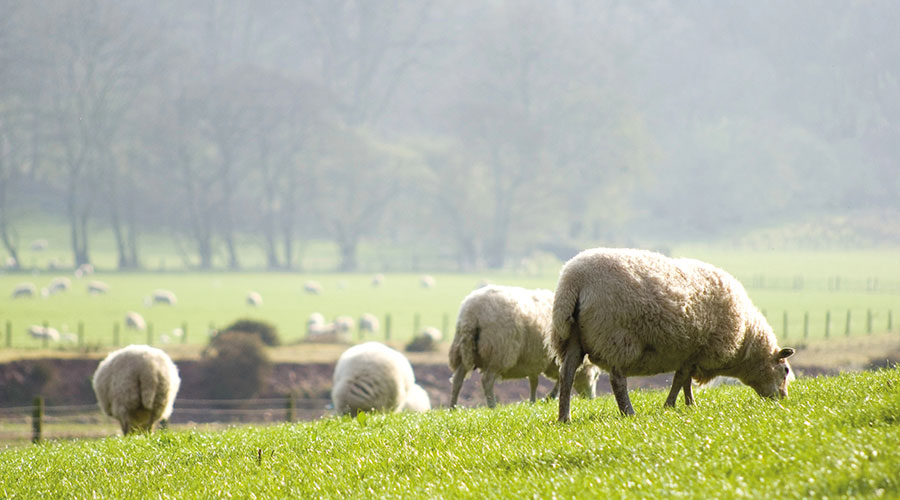Unpredictable weather creates challenges for silage and parasites
16th December 2024
As 2024 comes to an end we take a look at the key animal health challenges from the year. Sarah Kidby reports.

BTV-3 was the biggest headline news when it comes to animal health over the past year, but extremely wet weather also had significant implications for silage quality and the timings of parasites.
We spoke to experts to find out how to mitigate the animal health impacts of increasingly unpredictable weather.
A bad year for silage
In a year when it was wet when it should have been dry, and lacking sunshine in the summer, it’s fair to say that silage quality has suffered. Some farmers have even said it’s the worst year they’ve ever known, said Alison Bond, Rumenco technical services manager.
“Generally from a nutritional point of view, what we’re seeing is forages that were either taken too early so they’re mixed, poor quality, or taken too late because the rain came, resulting in higher fibre levels,” she commented. “We’re seeing wetter forages, whether it’s silage in the clamp or even some of the big bales going out for sheep. That wetter forage is going to interfere with dry matter intake.”
Second cuts appear to be a little better as they were left for longer, but the first cuts were very variable, meaning forage analysis has been particularly important this year.
“Spending £30 on a mineral forage analysis could save you quite a bit in the long run if it means that you feed something that’s going to be bespoke for your farm or closer to what you need,” Alison added.
Lower protein and sugar this year could impact rumen health with consequences for milk yields and colostrum quality in the approach to lambing. Additionally, grass that’s been waterlogged can leach minerals, vitamins and trace elements, resulting in health issues – selenium, cobalt and iodine are particularly important for animal health and immunity.
When it comes to supplementation, the most important thing to consider is what you’re looking to achieve, Alison said. Flexibility is also key as the weather becomes increasingly unpredictable – gone are the days when silage can be cut on the same day every year, or when the same amount of forage can be fed year on year.
“It’s about having that flex and using all the tools in the kit, whether that be your nutritionist or your supplier, to make sure you’ve got the full picture,” she concluded. It’s also worth speaking to an agronomist for advice to help optimise cutting time.
Shifting timings
Increasingly unpredictable weather is disrupting typical patterns when it comes to parasites – worms have a habit of making up for lost time when conditions allow and we’ve seen worm problems right through the mild autumn. It’s more important than ever for sheep farmers to be on their guard and keep monitoring, said independent sheep consultant Lesley Stubbings, speaking on behalf of SCOPS.
“You look at the old graphs that show the pattern of worm activity over a year and the changing weather patterns are just to a large extent, tearing that up,” she commented. “[…] We get worm activity all winter when it’s mild and then in the summer we can go through periods when there’s very little activity if we get a dry, hot spell.
“Farmers have got to be really aware of the weather conditions on their farm and the age of animals, and be doing their monitoring now because we can no longer make assumptions.”
At the end of October, SCOPS warned farmers that the wet summer and autumn could bring higher levels of liver fluke, following several years of relatively low levels due to dry springs and hot, dry summers. This warning has now come to fruition, with localised reports of disease starting to come in by late November. “It’s not a mega year, but it’s a lot higher than we’ve seen for several years,” Lesley added.
Sheep farmers are advised to test and look into sudden deaths – get a post-mortem done and pay attention to abattoir feedback. On the other hand, Lesley warned against reaching for the drench gun and having a false sense of security – testing is vital to ensure treatments are done at the right time, and that they’re working.

Additionally, a new lateral flow test for liver fluke recently launched. Much like a covid test – except it requires drops of blood from an ear or nose prick – it offers results in 30 minutes and is available from your vet. Ten tests are needed in a mob to get a statistically significant sample.
With many farms still unsure about their resistance status, it’s also important to make use of the funding for a Worm Treatment Check under the government’s Animal Health & Welfare Pathway scheme. A similar scheme is available under the Scottish farming incentive. Farmers can also use the SCOPS principles to slow resistance on their individual farms.
Cattle testing
While timings are being thrown out by unpredictable weather, Control of Worms Sustainably (COWS) said there were no spikes in infection in roundworms, lungworms and liver fluke among grazing cattle. COWS said 2024 has been a relatively ‘normal’ year in terms of parasite challenge for grazing cattle.
“The ones to watch out for are roundworms during the summer, lungworm in the summer and autumn and liver fluke from late summer onwards. Despite being a very wet year, there have been no spikes in infection in any of these species.”
Anecdotal evidence, however, suggests there were increased numbers of flies affecting cattle in the summer.
COWS agreed that the longer, wetter grazing season puts a greater emphasis on diagnostics and monitoring. For example – doing faecal egg counts for roundworms to check a need for treatment, keeping an ear out for any coughing in the herd, which could be lungworm and getting the vet involved as early as possible, and testing for liver fluke – a few weeks after housing.
Testing is becoming more critical in any risk assessment for any internal or external parasite made before treating, COWS noted. “Routine lungworm vaccination of first season grazing calves should be considered for calves born into herds with an identified lungworm risk or where there is a previous history of lungworm on the farm.”
Farmers were advised to order their lungworm vaccines in the new year to receive the first dose in time for administration pre-turnout.
BTV concern for spring
At the time of writing there had been over 160 cases of bluetongue serotype 3. Modelling suggests movement restrictions have considerably slowed progression and protected many livestock dense areas – but farmers in affected zones have reported significant financial issues.
Ami Sawran, clinical director at Westpoint Farm Vets, Chelmsford, said: “As the weather cools to remain consistently below 5 degrees, we can expect to see midge populations die off, but modelling suggests a possibility that we will see a resurgence in the spring; calves and lambs born to infected dams could remain reservoirs of infection, and as temperatures creep up, midges could start to spread the disease once again.
“Of course, BTV doesn’t have a playbook – it could be that we do not encounter the severe issues noted on the continent, but preparedness and vigilance is still paramount.”
Vaccines have been permitted for use, with some claims of reducing clinical signs and mortality. “Timing of these vaccines to suit your farming system and intended purpose of livestock is important and should be discussed with your vet,” Ami advised.
Ami also emphasised the importance of reporting BTV – a notifiable disease – as it shares similar clinical signs with arguably more serious diseases like foot and mouth.
Top tips for preventing calf pneumonia
A recent Galebreaker webinar saw experts discuss ways to prevent calf pneumonia and protect future productivity.
Kat Hart, a youngstock specialist from George Vet Group, and Chloe Rodriguez from Galebreaker’s animal welfare team, shared their essential tips to minimise disease risk in calves.
Environmental factors such as moisture, hygiene, air quality, and ventilation play a fundamental role in managing calf pneumonia. Kat explores their effect on calves’ temperature.
“In the way wet clothes feel cold to us, the same is true for calves – damp conditions increase calves’ lower critical temperature (LCT) by 6ºC,” says Kat. “A typical Holstein calf has a LCT of 15ºC. Any lower temperature means the calf is using its own energy to keep warm instead of growing and running its immune system.”
Similarly, calves exposed to draughts are increasingly vulnerable, with damp humid conditions also providing an ideal pathogen breeding ground.
Kat recommends exploring three strategies to maintain body temperature: calf jackets, shed heaters or heat lamps, and introducing more feed concentrate, whether at higher volumes or at a consistently higher quality.
Keeping on top of shed cleanliness also supports calf health. After removing all organic matter and disinfecting, thoroughly steam clean or pressure wash sheds as a minimum.
Kat adds: “There’s one option for reducing pathogens, which is often overlooked, and probably the simplest and cheapest solution. That’s time and UV light. Having a two-week rest period in sheds gives them time to fully dry out, killing a high proportion of pathogens.”
When it comes to reducing respiratory disease, Chloe suggests a thorough assessment of buildings including drainage, air quality and ventilation.
“Good natural ventilation in sheds will displace heat, moisture, noxious gases and airborne pathogens,” she says. “It’s vital to ensure regular air exchanges and a continuous flow to remove ‘contaminated’ air.”
In cold weather calves need between 4–6 air changes per hour. However, as their bodies do not produce enough heat to circulate the air properly, they often benefit from assistance such as positive pressure tube ventilation (PPTV).
“PPTV is a self-contained system consisting of a fan and tube that supplements natural ventilation,” Chloe adds.
Galebreaker supplies bespoke systems that are based on the building’s volume and pen layout requirements. The fan delivers fresh air along the length of tube without creating draughts. Research suggests customers with PPTV systems typically report a 25–75% reduction in calf pneumonia treatments.
“To minimise the risk of pneumonia, try thinking holistically about calf rearing. From nutrition, to housing, stocking density, vaccination or better management of their environment, there are always ways to improve,” Chloe concludes. “Often lots of small changes make for big wins.”
The next Galebreaker animal health webinar is scheduled for April with a focus on the prevention of heat stress in dairy herds.
Read more livestock news





